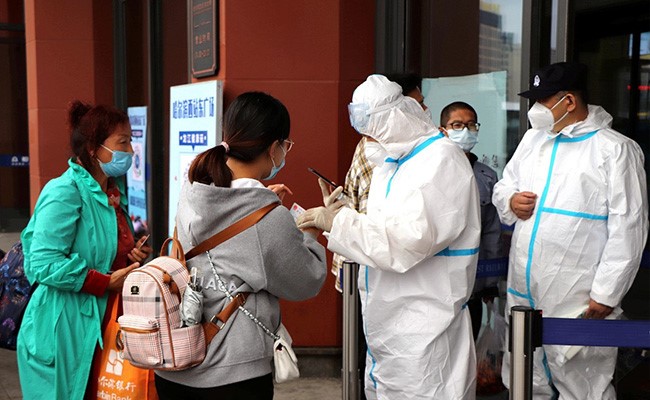China claims it is now hard to track Covid cases as infections surge.

As officials warned of a quick spread in Beijing following the country’s unexpected abandonment of its zero-tolerance policy, China’s top health agency declared Wednesday that it is now “impossible” to track the exact amount of COVID-19 infections in the nation. After nearly three years of trying to eradicate the virus, China this week relaxed its mass testing and quarantine regulations. As a result, officially reported illnesses dropped sharply from their record highs reached last month.
Furthermore, because testing was no longer required across the majority of the country, China’s National Health Commission stated on Wednesday that their figures no longer correctly reflected reality. Many asymptomatic people are no longer engaging in nucleic acid testing, therefore it is difficult to accurately estimate the exact number of asymptomatic infected people, according to a statement from the NHC. The announcement comes as Vice Premier Sun Chunlan said that new ailments were “rapidly growing” in the capital, according to state media.
Chinese leaders are adamant about moving forward with openness; on Tuesday, the Beijing tourist bureau announced that tour groups will once again be allowed to enter and exit the city. However, the nation is currently dealing with an increase in cases that it is ill-prepared to handle, with millions of frail old people who are still not completely immunized and underfunded institutions that lack the means to handle an anticipated inflow of infected patients.
Many people who are experiencing symptoms have chosen to self-medicate at home as the nation navigates a hard route away from its “zero-tolerance” policy towards living with the illness. Long pharmacy lineups and sold-out cold medications have been complaints from Beijing residents, while the Chinese search engine giant Baidu reported a 430 percent increase in searches for the fever-relieving drug Ibuprofen over the previous week. Rapid antigen testing and treatments are in such high demand that there is now a black market with exorbitant costs, and purchasers are forced to purchase the products from “dealers” whose connections are circulated among WeChat groups.
The local Beijing News claimed on Tuesday that authorities are clamping down and fining one Beijing company 300,000 yuan ($43,000) for selling test kits at exorbitant prices. People are now turning to social media to brag about their test results and describe their illness in great detail, marking a sea change in a society where the virus was formerly taboo and recovered patients suffered prejudice.
User “Nina” from Beijing’s Xiaohongshu social network advised people who were not yet sick to add sugar and salt to their lemon water after their body temperature was above 37.2 degrees.
On Tuesday, China reported 2,291 additional confirmed cases, a fraction of the 30,000 new infections per day that the nation was reporting before lifting the bulk testing mandate. Beijing has made a major effort to persuade the public that it can withstand the possible dangers of loosening regulations and still bring the second-largest economy in the world back on track after China abruptly changed direction and relaxed its zero-tolerance stance to COVID last week.
Previously grim predictions have become downright upbeat: According to one of the foremost experts on the coronavirus in China, COVID-19 is in its “final stage” and will soon turn into a treatable seasonal sickness. Another well-known Chinese researcher projected that the virus’s transmission would peak in a month. Given that the most recent COVID variations are less harmful and that officials claim the nation’s medical preparation would guard against the worst-case scenarios, a leading state TV news anchor claimed that “we are on the road” to ending the crisis.
Even with such guarantees, China is unsure of how the upcoming months will turn out. It will be challenging to evaluate Beijing’s response to the upcoming wave of COVID infections due to the opaque and inaccurate nature of the information. The government’s need to seem respectable following a humiliating retreat from its defining pandemic strategy will only cloud the situation.
There are already indications that China is using propaganda to support the idea that the situation is under control. Furthermore, without a steady stream of information, foreign companies and investors are forced to guess how long the country’s economy will take to recover. Due to the government’s relaxation of mass testing regulations and the voluntary reporting of at-home test results, it is difficult to even answer the most basic question regarding the number of COVID-infected individuals in China at this time.
Tuesday saw China report 2,291 fresh confirmed cases; down from the nearly 30,000 new infections it recorded before removing the bulk testing mandate. After China’s National Health Commission said on Wednesday that it will stop reporting asymptomatic infections, which constituted the great majority of positive results in the past, case counts are certain to be further lowered.
Anecdotal reports of a rise in positive cases and overflowing hospitals with patients waiting to be treated contradict the decline in recorded illnesses. Due to the shift in testing policy, several towns and counties all around the nation are promoting the idea that testing should only be done when necessary on official social media. Jörg Wuttke, head of the European Union Chamber of Commerce in China, declared that the data were useless.
For a nation with a population of 1.4 billion, some of China’s data goes beyond what is reasonable. China said that after lifting pandemic restrictions six days ago, there have been no deaths associated with COVID. In contrast, the US reported 469 COVID-related fatalities just on Tuesday.
Since the beginning of the epidemic, virologists have questioned China’s official mortality statistics and questioned how the nation’s hospitals categorize COVID fatalities. Chinese hospitals generally attribute fatalities to preexisting or chronic conditions, such as cancer or a heart ailment, rather than mentioning those who died after catching COVID-19 in official records, as is the custom in other nations, they added.
Although China is not the only nation that underreports COVID cases, it is still exceedingly challenging to comprehend. The government only publishes the daily change in the number of cases, not the overall number, when reporting “severe” COVID outbreaks. China reports that there were three more serious incidents on Tuesday than there were on Monday.
It is difficult to predict how long it will take for the economy to recover due to the absence of trustworthy data on COVID cases. With both the United States and Europe headed for recession, the demand for Chinese exports, a solid foundation of the global economy, is suffering. The global picture does not appear good.
The continual fear of lockdowns and erratic quarantines under China’s no-holds-barred COVID policy also kept customers out of businesses, chained tourists to their homes, and deterred diners from eating out for the better part of three years. Even though patrons are now able to leave the establishment without restriction, there is still a lot of uncertainty regarding the future. Since there are still no clients, Zheng Jingrong, a Beijing shop owner who offers handcrafted imported clothing, said she hasn’t bothered to restart her business.
She stated, “My impression right now is that everyone is frightened of testing positive, and the timid do not go out.” Although loosening the nation’s COVID regulations is a positive first step, Zheng added that “nothing is definite at the time” and that “the government has to do more to help common citizens and small companies.”)
Nomura, a Japanese firm, employs Ting Lu as the head economist for China. He said he wasn’t “very hopeful” about a swift rebound in the Chinese economy because he anticipates ongoing disruptions from an overburdened healthcare system and a rise in infections. He continued by predicting that the economy’s pent-up demand will be “pretty weak” in 2019 following three years of financial ruin caused by lockdowns in China. No nation of this scale has ever changed course so abruptly, going from a full-on COVID attack to learning to live with the virus, which contributes to the ambiguity around how China will leave “zero COVID.” Long-standing conventions are evolving every day.
As of last week, asymptomatic or mild cases were no longer necessitating hospital admissions. The lifting of all limitations on buying painkillers and flu medications coincided with a surge in demand for fever reducers and even certain traditional Chinese remedies. A trip monitoring app, one of several smartphone applications the Chinese government uses to monitor Chinese people’s travels and determine their COVID risk, was also deactivated on Tuesday.
Before the massive public outcry over the government’s harsh COVID measures two months ago, China’s leader Xi Jinping declared that combating COVID required an “all-out battle” since it presented such a serious threat to public health. It’s incredible how the entire control system has vanished in just two weeks,” Wuttke said.
According to Mark Woolhouse, a professor of infectious disease epidemiology at the University of Edinburgh, Australia and New Zealand were able to abandon their zero-COVID goals last year with some success since they had put in place “good immunization programs with effective vaccinations.”
Both of those considerations, nonetheless, are debatable in the case of China. In China, just 40% of those over 80 and almost two-thirds of those over 60 had gotten a booster injection. When it comes to China’s domestic vaccinations, which employ inactivated viruses and have been proven to be less effective than their international counterparts that use more modern mRNA technology, the World Health Organization has said that boosters are crucial. China’s health authority said on Wednesday that it was introducing a second vaccination booster for high-risk groups and adults over 60.
The “potential for a very major public health disaster” exists in the absence of comprehensive coverage and a very efficient vaccination, according to Woolhouse. The COVID limitations harmed Zhu Yan’s hostel beside Qionghai Lake, a popular tourist attraction in Sichuan province. She said that because people are worried about getting the virus, there are still no visits. She acknowledged that it could take some time for both the economy and her business to revive, but at least she was feeling optimistic once more.
The 40-year-old Zhu expressed her desire for China to achieve herd immunity so that things could get back to normal. She anticipates testing positive shortly since she believes that getting COVID early is preferable. It’s not conceivable to imprison everyone at home for all time, is it? Said Zhu. “You cannot escape what must happen; it will arrive.” Everyone must follow this road for China to resume its regular business and way of life.
edited and proofread by by nikita sharma




